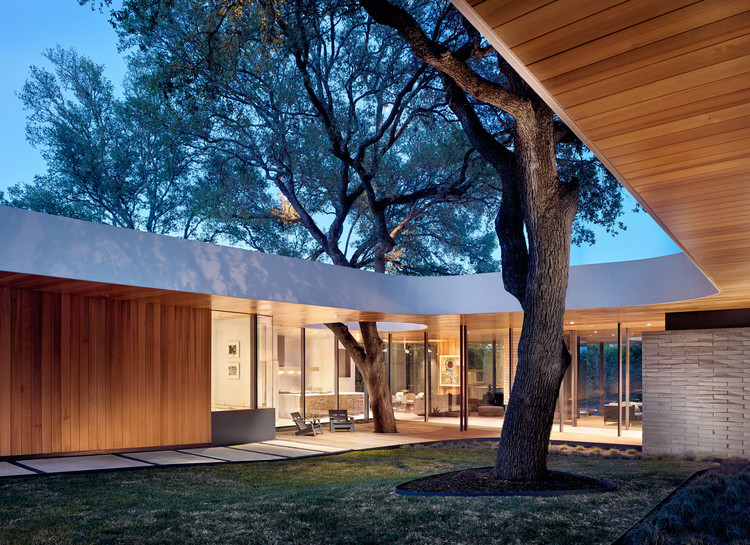New Jindai Elementary School TEKTAO
2011-05-20 00:00
架构师提供的文本描述。2010年1月,中美可持续发展中心与TEKTAO接洽,领导梁平县一所新的可持续发展学校的设计和施工协调,以取代2008年地震中受损的一所学校。该项目从一开始就提出的目标是建设一所安全、可持续、可扩展和成本效益高的学校。学校简要说明了560名学生(12个班)和5000平方米的项目,预算为1500万元人民币,部分由梁平政府捐赠,部分由慈善机构捐赠。选择的地点是一个美丽的地块梯田在农村的金代县,对面的古老双桂寺。在与美国绿色设计专家合作进行了三个月的设计阶段,然后是为期六周的建设文件期之后,该学校正在建设10个月,并于2011年4月竣工。在开幕式的前一周,TEKTAO与同济大学一起领导了一个研讨会,让金代学校的学生和教职员工,以及当地社区,为学校的生态和社会设计理念向现实世界的实践转变提供便利。
Text description provided by the architects. In January 2010, the China-US Center for Sustainable Development approached TEKTAO to lead the design and construction coordination of a new sustainable school in Liangping County to replace one damaged in the 2008 earthquake. The goals outlined from the onset of the project were to build a safe, sustainable, scalable, and cost-effective school. The school's brief specified 560 students (12 classes) and 5,000 m² of program with a 15 million RMB budget that was donated in part from the Liangping government and in part by charitable organizations. The site chosen was a beautiful plot of terraced agriculture in the rural Jindai County, just opposite the ancient Shuang Gui Temple. After a three month design phase in collaboration with American green design experts, followed by a six week construction document period, the school was under construction for 10 months and has been completed as of April 2011. During the week directly preceding the opening ceremony, TEKTAO lead a workshop along with Tongji University involving the Jindai school students and faculty, along with the local community, to facilitate the transition of the school’s ecological and social design ideas into real-world practices.
在这个项目中,我们的目标是创建一个模范学校,通过综合而又成本效益高的可持续方法,尊重自然、文化和社区并与之互动,这些方法既具有本土性,又具有可复制性。我们以教育“游乐场”的形式和综合的社区计划来实现这一目标。
In this project, our aim was to create an exemplary school that respects and interacts with nature, culture, and community through comprehensive yet cost-efficient sustainable methods that are both vernacular and replicable. We achieve this in the form of an educational 'playground' with integrated communal program.
我们确定的主要问题是解决运行轨道的编程需求,同时最小化对地形紧张的站点的干扰。我们的设计解决方案将轨道置于最佳高度,将有效的分级和最小的支撑结构结合起来,创建一个活动平台,从地板过渡到屋顶,并成为场地植物中心3 000平方米的保护屏障。通过重定向看似相互冲突的元素,对网站构成最大威胁的程序成为了它的监护人。该建筑布局,组织和分配课程围绕中心,最大限度地发挥学生与他们的环境互动,同时在结构上支持轨道。新定义的“天道”是复合程序的反应:将跑步道、操场、走廊、观景台和事件舞台的功能结合在一个几何学中,包括场地,并强调对寺庙的看法。入口处与一个公共社区中心相结合,作为传统学校方案的补充,以促进与村民的互动。
The main problem we identified was resolving the programmatic requirement of a running track while minimizing disturbance to a topographically intense site. Our design solution places the track at an optimum height that combines efficient grading with minimal support structure to create an activity platform which transitions from floor to rooftop and becomes a protective barrier for 3,000 m² in the vegetated heart of the site. By redirecting seemingly conflicting elements, the program that most threatens the site becomes its guardian. The building layout, which organizes and distributes program around the center, maximizes the students' interaction with their environment while structurally supporting the track. The newly defined 'skytrack' is a response of compounded program: combining the function of a running track, playground, hallway, viewing deck, and event stage in a geometry that embraces the site and emphasizes views to the temple. The entrance is combined with a public community center as an addition to the conventional school program in order to promote interaction with the villagers.
我们的可持续规划的重点是低成本,高影响的保护,再循环和舒适的战略,适合梁平的潮湿亚热带气候。梯田地形自然地适合人工湿地;该场地适合处理废水和雨水,创造了一个低维护、封闭的有机基础设施,每天处理4800加仑的水。落在建筑物和轨道上的雨水是在邻近的湿地池塘中收集的。当下雨时,这片湿地会清理雨水,然后将雨水从几个池塘中泻下,成为一种景观特征,一直延伸到学校入口处。此外,双冲水马桶有助于调节用水。
Our sustainable planning focuses on low-cost, high impact conservation, recycling, and comfort strategies tailored to Liangping's humid subtropical climate. The terraced topography naturally lends itself to constructed wetlands; the site is adapted to treat both wastewater and rainwater, creating a low-maintenance, closed-loop organic infrastructure that treats 4,800 gallons of water every day. The rainwater that falls on the buildings and the track is collected in an adjacent wetland pond. When it rains, this wetland cleans the rainwater which then cascades down several ponds to become a landscape feature that reaches all the way to the school's entrance. In addition, dual-flush toilets help regulate water use.
根据对当地太阳路径和风升的分析,建筑物的最佳方向是捕捉光和盛行风。利用Ecotect进行了太阳射线研究,以确定教室内轻型货架和天花板的位置。整个学校都使用LED照明,以降低用电和成本。
Buildings are optimally oriented to capture light and prevailing winds based on analysis of the local sun path and wind rose. Solar ray studies were performed using Ecotect to determine the placement of light shelves and ceiling pitches inside the classrooms. LED lighting is used throughout the school to lower electricity usage and costs.
被动式暖通空调系统使用稳定的地面温度来调节教室建筑。该系统由几根挖入地下4-5米的管子组成,这些管子与天花板上的管道系统相连。风扇用于泵出空气并将空气从管道输送到教室,以增加室内舒适性和新鲜空气供应,从而改善教室内的整体空气质量。
A passive HVAC system uses stable ground temperatures to condition the classroom buildings. The system is composed of several tubes dug 4-5 meters into the earth that are connected to the duct system in the ceiling. Fans are used to pump out and deliver air from the tubes into the classrooms to increase interior comfort and fresh air supply, thereby improving the overall air quality inside the classrooms.
景观中的农田恢复了活力,包括厨房顶部的作物屋顶,特色是为自助餐厅提供新鲜原料(卷心菜、白菜、玉米、菜籽和韭菜)的特有作物种类,以及户外农耕教室专用区域。
Revived agriculture fields in the landscape, including a crop roof on top of the kitchen, feature endemic crop species that provide fresh ingredients (cabbage, bak choi, corn, rapeseed, and chives) for the cafeteria as well as dedicated areas for outdoor farming classrooms.
在整个过程中,使用了一系列回收的、区域性的和可再生的材料:从北川废弃的地震掩体中打捞出泡沫保温板,并将其纳入教室墙壁。砖块和地砖从被拆除的现场建筑被重新使用,以创造景观池塘。竹子在该地区生长丰富,广泛应用于教室楼梯外和学校大门上。社区中心立面由当地石材组成。
A range of reclaimed, regional, and renewable materials are used throughout: Foam insulation panels are salvaged from defunct earthquake shelters in Beichuan and incorporated into the classroom walls. Bricks and floor tiles from a demolished on-site building are reused to create the landscape ponds. Bamboo, which grows abundantly in the region, is used extensively in the exterior of classroom stairwells and on the school gate. The community center facade is composed of local stone.
新金代学派深深植根于周边环境中。建筑与自然的关系与重庆的物理特征相呼应,重庆被称为“山地城市”,那里的山峰很容易侵入城市结构。我们的设计为邻近的寺庙提供了一个无处不在的观看平台,在整个校园内将其可视化地集成在一起。结构设计符合最严格的抗震规范。
The New Jindai School is deeply rooted in the surrounding context. The relationship between building and nature echoes the physical characteristics of Chongqing- known as the "mountain city"- where peaks readily invade urban fabric. Our design provides the adjacent temple with a ubiquitous viewing platform that visually integrates it throughout the campus. The structure is engineered to meet the strictest seismic codes.
 举报
举报
别默默的看了,快登录帮我评论一下吧!:)
注册
登录
更多评论
相关文章
-

描边风设计中,最容易犯的8种问题分析
2018年走过了四分之一,LOGO设计趋势也清晰了LOGO设计
-

描边风设计中,最容易犯的8种问题分析
2018年走过了四分之一,LOGO设计趋势也清晰了LOGO设计
-

描边风设计中,最容易犯的8种问题分析
2018年走过了四分之一,LOGO设计趋势也清晰了LOGO设计






























































































































_james_jones.jpg)







